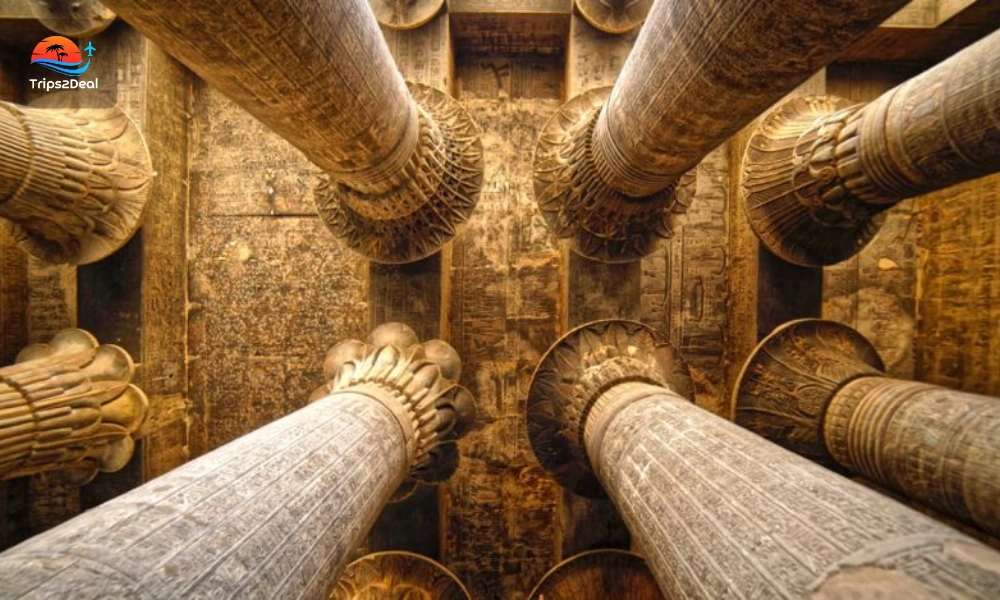Blogs

Esna Temple
Esna temple which is also known as a temple of Khnum. Tourists mostly overlook it by rushing toward famous temples like Karnak and Luxor. Esna temple is located on the west bank of the Nile river and 55 kilometers south of modern city Luxor. This temple showcases the rich history of ancient Egypt and blends Roman, Ptolemaic, and Pharaonic influences. Let's read about its rich history, architecture and restoration efforts.
Table of Contents
Historical Background Of Esna Temple
This temple was dedicated to the god of Nile creation and inundation Khnum ( ram-headed ). Esna temple was constructed in between the 1st and 3rd centuries AD of Roman rule while its construction started in the Ptolemic period. Although there are some signs that indicate that this temple was sacred long ago. The representation of religious life of Egypt makes the temple significant. The art work in the temple showcases the representation of how Egypt's religious practices evolved while maintaining the deep traditional roots under the period of Roman emperors such as Claudius and Decius. This temple was a spot for the ancient Egyptian religious festivals. Locals worshiped the Khnum along with the other deities like Neith, Satet, and Anuket. Mostly the Nile flood festivals were celebrated in order to maintain the fertility and abundance for the upcoming year.
Architecture And Inscriptions Of Esna Temple
The hypostyle hall supported by the 24 columns and each with distinct floral and palm-leaf capitals makes it the most attractive part in Esna Temple. The original colourful paintings can be seen on the ceiling of the temple including the astronomical scenes, constellations, zodiac signs, and sacred deities. The art work of the Esna temple is well preserved allowing visitors to see the ancient Egyptian art skills in modern days. As in other temples, inscriptions are submerged due to sand and erosion but this temple remains well preserved as the hieroglyphic inscriptions on columns and walls seems to be freshly carved. The liturgical texts and prayers provide insights into ancient Egyptian prayers during the Roman and ptolemaic rules. The idea of Skills of ancient craftsmanship can be assumed by the architecture of the temple and it was constructed by using the locally sourced sandstone.

Restoration Efforts Made In Temple
The temple has been restored by the Egyptian authorities and international archaeologists by cleaning the centuries of soot, dirt, and debris off the temple’s surfaces. The restoration effort not only makes it visitable but also helps in understanding the previously unreadable hieroglyphs. These hieroglyphs offer the insights of an ancient Egyptian religious and political landscape during the Roman era.
Facts About Esna Temple
Some fascinating facts about the temple are:
- The temple was excavated in the 19th century as it got buried under several meters of debris and mud.
- The name Esna is derived from the ancient Egyptian word “Latopolis” which referred to the sacred Nile perch fish.
- Many inscriptions inside the temple indicate that the Roman emperors dressed like the pharaohs in order to gain popularity among the local populations.
- Esna is one of the temples where you can see original colourful paint on the pillars and ceilings.
How To Reach To Esna Temple
Esna temple can be accessed easily by a car and also can be an itinerary in a Nile Cruise of Luxor. There is a smooth drive of an hour on your Nile cruise trip. As the Egypts summer heat is intense, it will be best to visit the temple during the months of October to April. Hire a local tour guide for understanding the temple's rich history. The temple is located in the main town of Esna and after the visit to the temple you can also explore the local town market of spices, handicrafts and clothes.
We know Egypt is a home to countless archaeological sites and Esna temple is one from the list where you can truly observe the beauty of ancient Egyptians' rich history showcased by the artwork. It really takes you back to ancient times. So, if you are going to Luxor add Esna temple in your list for enhancing your history exploration tour.





